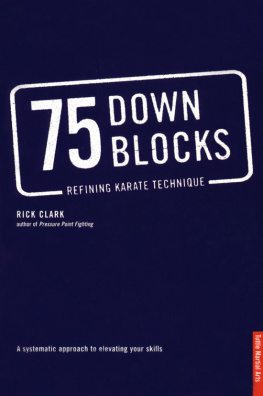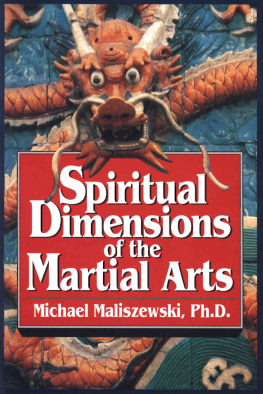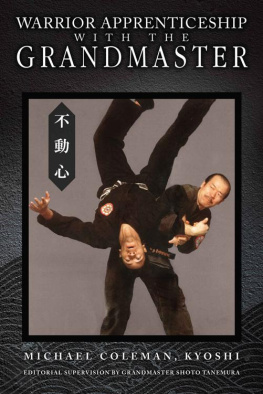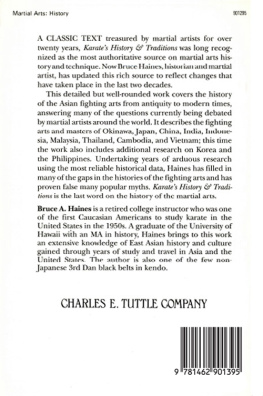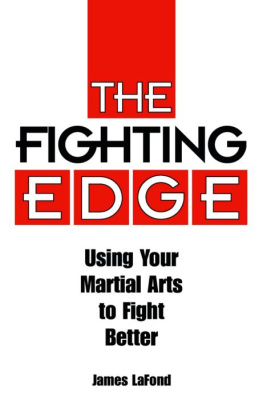Contents

Disclaimer: Please note that the publisher and author(s) of this instructional book are NOT RESPONSIBLE in any manner whatsoever for any injury that may result from practicing the techniques and/or following the instructions given within. Martial arts training can be dangerousboth to you and to othersif not practiced safely. If youre in doubt as to how to proceed or whether your practice is safe, consult with a trained martial arts teacher before beginning. Since the physical activities described herein may be too strenuous in nature for some readers, it is also essential that a physician be consulted prior to training.

ACKNOWLEDGMENTS
There are so many people in my life that I would like to thank for the opportunity to write this book that I even hate to do so, for fear of leaving a person out. First on my list of thanks must be my wife of 24 years, Patricia Clark, D.D.S., M.S.D., who has been a martial arts widow on too many occasions. My children, Jason and Matthew, who have seen their dad leave home for weeks at a time so that I might be able to teach seminars around the world. Without their understanding and support I would never have been able to pursue the martial arts in the way that I have.
Without a doubt I must thank all of the instructors I have studied under, even if it was only for a day in a seminareven the white belts I have taught, because they have been able to teach me many lessons in the martial arts. To all of these individuals I owe a deep debt of gratitude. But in the production of this book there were a few people who suffered the photo sessions with good grace and patience. For them there is a special thanks for their effort. They are Shane Leib, Mike Muarry, Steven Webster, Sigbjorn Strommen, Ricco Blom, Patrick Melkersson, Mikael Ogren, and I would also like to thank my editor, George Donahue, who has been very helpful with the production of this book, and without whose support this book would never have come to fruition.
FOREWORD BY JANE HALLANDER
In my fifteen years as a martial arts journalist, I have seldom seen a martial artist with the ability and knowledge of Professor Rick Clark. Professor Clark is a person who not only knows several martial arts from all angles, but can also write about them in a manner everyone easily understands. From the basic to the most advanced fighting techniques, Professor Clark explains and demonstrates them clearly and with the knowledge of someone who can perform those techniques as second nature. His book is a treasure for levels starting with beginning martial artists, up to the most advanced. Not only does he detail important theories and martial arts principles, but he also delves into rare, little-known techniques and fighting applications. This is a book for all martial arts styles, not limited to a small segment of the martial arts worldas are most books. It is a must read for students, teachers, and those interested in learning more about common-sense martial arts and self-defense.
Author and photojournalist Jane Hallander has written for Black Belt, Inside Kung-Fu, Martial Arts Training, Karate International, Inside Karate, Inside Tae Kwon Do, Tae Kwon Do Times, Dojang, Dojo, and Kung Fu magazines.
FOREWORD BY VINCE MORRIS
In the world of the martial arts, there is much that is dross, much that is flim flam, and much that is simply bogus.
In this world, there are happily a few teachers who stand out from the morass and whose work illuminates much of the darkness.
As someone whose background was firmly seated in Japanese instruction and who followed a similar course of discovery, I can appreciate perhaps more than most the qualities of resolution and determination that were necessary to overcome the blinkered and short-sighted attitudes of so many who should have known better in bringing the truths of the martial arts into focus.
I have a saying: You can tell the quality of a teacher by the quality of his students!
Having had the privilege of working with a number of Sensei Clarks students I can say quite honestly that they are a credit not only to his knowledge, but also to his methods of teaching, which are both effective and inspirational. That is to say, he not only enlarges their technical knowledge, but also instills within them the passion to learn more and then to understand the principles beneath the surface knowledge. Thus a student who has Sensei Clark as his master will be encouraged to seek out the truth and will not be confined to the narrow reaches of any particular style or method.
Given the prevalent protectionist attitude of many of todays teachers, this brings us immediately back to the example of the true Okinawan masters, who would encourage their students to achieve mastery by learning from others.
Master Clark has a broad, eclectic depth of knowledge upon which he has based his teaching, and from which he has teased out those areas of common ground that underlie all true martial arts and that are often neglected in the present day aim of sporting success and the collection of medals.
The student who carefully applies the methods he or she receives from this teacher will be able to have the confidence that the techniques will be effective in the real world, where the only worthwhile trophy is to go home with a safe skin.
The understanding that he or she will gain will also serve to shed light on a vast range of techniques, because the principles themselves will be clear.
I wish master Clark well, and I hope he will continue to tread his path so that he can continue to exemplify the concept embodied within the word Senseione who has trodden the path before and who now guides others along it!
Vince Morris (BA Hons.) 6th Dan
Chief Instructor Kissaki-Kai Karate-Do
Director International Institute for Kyusho-Jutsu Research
American Society for Law Enforcement Trainers
PREFACE
As many have stated previously, martial arts is a lifelong pursuit. In 1962 when I first began my training, I was 14 years old. I was young, flexible, in good physical shape; now, in 2000, I am 51 years old, not as young, not as flexible, and not in the best of shape. But I am confident I am a better martial artist today than 37 years ago. I am a better martial artist today than I was 20 years ago, or 10 years ago. Each day should be viewed as an opportunity to become a better person and martial artist. I hope that in the remaining years of my life I will continue to develop as a martial artist and as a human being.
One very strong influence on my martial arts was my first instructor, Wesley Hughes. He was in a very bad car accident and unfortunately was confined to a wheelchair as a quadriplegic. While this might have caused a lesser man to give up the martial arts, he continued to coach our club from his wheelchair. There have been times I have not felt like teaching a class or working out because of a headache, cold, or other malady. But how could I let a little thing like that stop me when Hughes Sensei would not stop? What kind of a lesson did that teach me? I dont think I would be able to adequately express my feelings even in a book. I hope you will be able to glean some small measure of my gratitude and respect for my first instructor.


